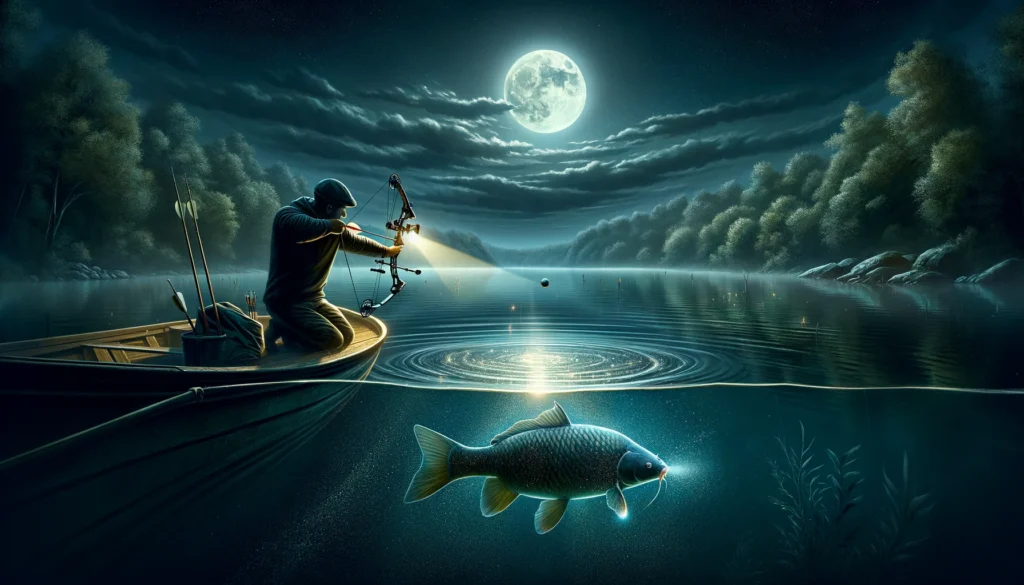Mastering the Thrill of Nighttime Bowfishing for Carp: An In-Depth Guide

Nighttime bowfishing for carp presents a thrilling blend of archery and fishing under the cloak of darkness. This guide is crafted to navigate you through the intricacies of gearing up, locating your target, and refining your technique, all while emphasizing safety and environmental stewardship.
Table of Contents
- Understanding Nighttime Bowfishing
- Essential Gear and Equipment
- Advanced Techniques and Strategies
- Ethical Considerations and Conservation
- Navigating Legalities and Permissions
- Enhancing the Experience
- Advanced Bowfishing Insights
- FAQs: Nighttime Bowfishing for Carp
- Conclusion: Embracing the Nighttime Bowfishing Adventure
Understanding Nighttime Bowfishing
Nighttime bowfishing transforms the traditional daytime activity into a challenging and rewarding nocturnal pursuit. Carp, often underestimated, become the coveted targets, offering bowfishers a unique blend of sport and conservation efforts.
The Appeal of Targeting Carp at Night
Carp, with their notorious reputation for adaptability and proliferation, make for an ideal target. They thrive in various environments, often outcompeting native species and altering habitats. Nighttime bowfishing not only adds an element of challenge but also aids in controlling these invasive populations, contributing positively to local ecosystems.
Essential Gear and Equipment
The right equipment is paramount for success and safety in nighttime bowfishing. Here’s a more detailed look at what you’ll need:
Advanced Lighting Systems
- Submersible LED Lights: Enhance visibility and attract fish by submerging LED lights around your boat.
- High-Powered Spotlights: Useful for scanning larger areas and spotting carp from a distance.
Specialized Bowfishing Gear
- Bow: Opt for a bow specifically designed for bowfishing, with adequate water resistance and durability.
- Arrows and Points: Use fiberglass or carbon arrows equipped with specially designed points that prevent fish from detaching.
Personal Safety Equipment
- Reflective Clothing: Ensure you’re visible to others on the water.
- Waterproof Communication Devices: Keep in touch with your team, especially in remote areas.
Advanced Techniques and Strategies
Stalking and Positioning
Learn to move quietly and position your boat strategically to avoid spooking fish. Carp are sensitive to noise and sudden movements, so patience and stealth are key.
Shooting Accuracy and Refraction Compensation
Mastering the art of compensating for water refraction is crucial. Practice shooting in various water conditions to understand how light bending affects your perception of the fish’s location.
Ethical Considerations and Conservation
- Selective Harvesting: Focus on invasive species and practice catch-and-release with native species when possible.
- Respectful Disposal: Properly dispose of carp to avoid wastage and environmental harm.
Always verify local regulations regarding bowfishing, night fishing, and specific rules about targeting carp. Some areas might have restrictions or require specific permits.
Enhancing the Experience
- Use of Drones: For scouting and getting an aerial view of fish movements and habitat structures.
- Photography and Videography: Document your adventures with waterproof cameras and action cams for breathtaking night shots.
Advanced Bowfishing Insights
Adaptive Strategies for Different Water Bodies
- Rivers and Streams: Focus on areas where carp might congregate, such as near obstructions or in slower-moving water.
- Lakes and Ponds: Look for carp in shallow, warm areas, especially near vegetation where they feed at night.
Understanding the behavior of carp in various environments can significantly increase your chances of a successful catch.
Environmental Impact and Carp Management
- Habitat Restoration: Participate in initiatives that aim to restore habitats affected by invasive carp populations. Bowfishing can be part of a larger conservation effort.
- Community Engagement: Engage with local fishing communities to share insights, strategies, and promote sustainable practices.
Leveraging Technology for Enhanced Efficiency
- GPS and Fish Finders: Use these technologies to map out potential hotspots and save time when scouting locations.
- Mobile Apps: Several apps are designed for anglers and bowfishers, offering features like weather forecasts, lunar calendars, and community reports.
Mental and Physical Preparedness
- Stamina and Strength Training: Bowfishing, especially at night, can be physically demanding. Regular exercise can improve your stamina and strength for drawing the bow and maneuvering the boat.
- Mindfulness and Patience: The quiet of night fishing requires a calm, patient approach. Practice mindfulness to enhance your focus and enjoy the serene environment.
FAQs: Nighttime Bowfishing for Carp
1. Is nighttime bowfishing for carp legal everywhere?
Answer: No, it’s subject to local and state regulations. Always check the laws in your area before heading out.
2. What makes carp a popular target for nighttime bowfishing?
Answer: Carp are abundant, provide a challenge due to their size and behavior, and are often considered invasive, making their removal beneficial for local waterways.
3. How do I ensure my safety while bowfishing at night?
Answer: Wear a life jacket, use proper lighting, communicate with your team, and always be aware of your surroundings.
4. Can I use my regular hunting bow for bowfishing?
Answer: Yes, but it needs modifications like adding a reel and using appropriate arrows. Dedicated bowfishing bows are recommended for optimal performance.
5. How do I deal with the refraction of light in water?
Answer: Practice and experience are key. Aim lower than the apparent position of the fish, adjusting based on the depth and angle of your shot.
Conclusion: Embracing the Nighttime Bowfishing Adventure
Nighttime bowfishing for carp is more than a sport; it’s an adventure that tests your skills, patience, and respect for nature. It offers a unique way to experience the outdoors, under the cloak of darkness, where every sense is heightened, and every catch feels like a triumph. Beyond the thrill of the hunt, it’s a practice in conservation, helping to manage populations of invasive species and contributing to the health of aquatic ecosystems. By engaging in this activity, bowfishers not only enjoy the excitement of the chase but also play a crucial role in environmental stewardship.







